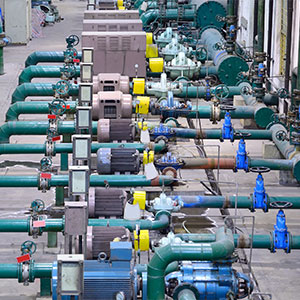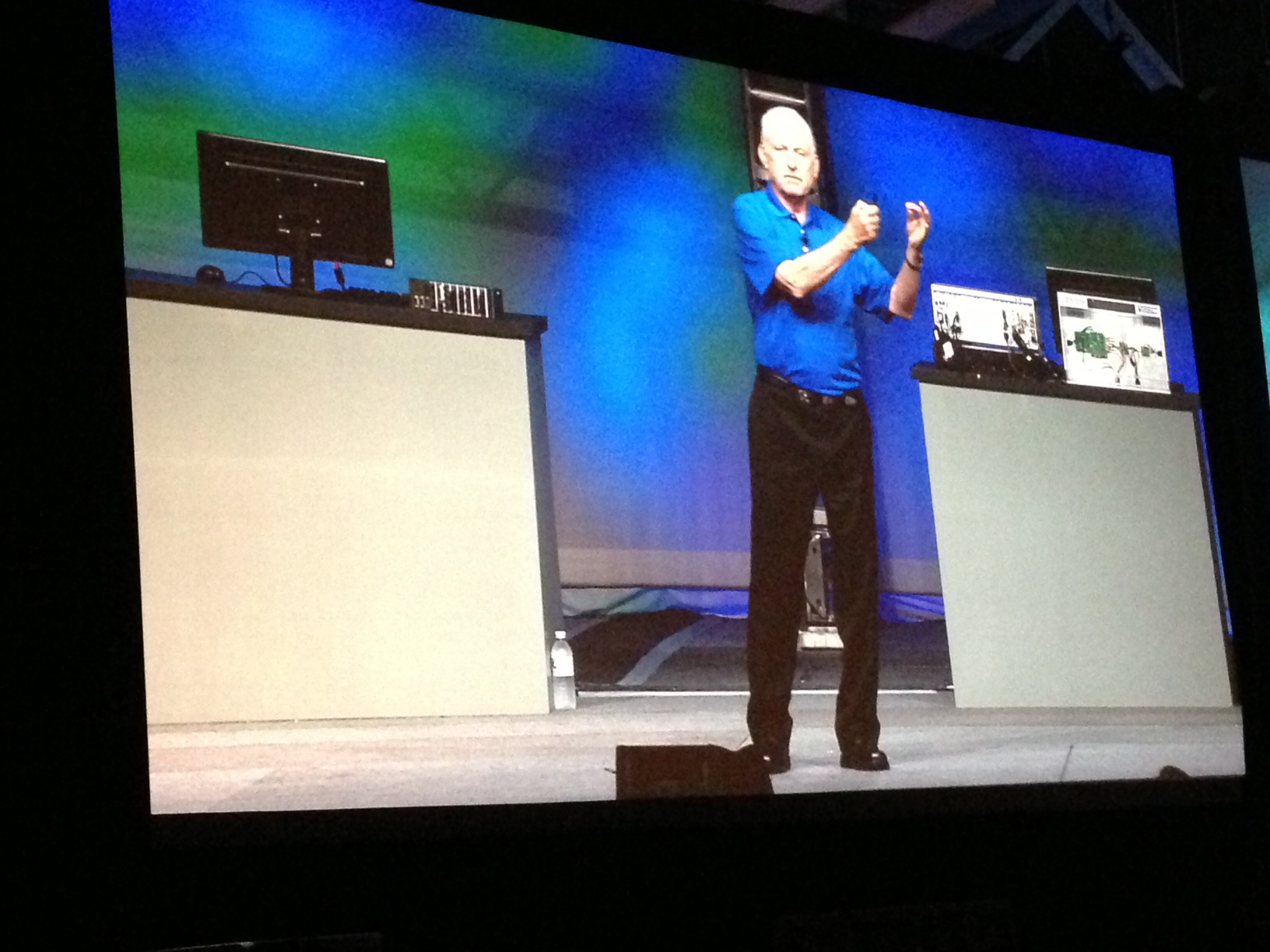
by Gary Mintchell | Oct 26, 2016 | Automation, Internet of Things

Figuring out how to assemble the pieces of the Industrial Internet of Things, the Industrial Internet Consortium promotes testbeds where collaborating companies can work out proof of concept.
National Instruments, SparkCognition, and IBM are collaborating on the Condition Monitoring and Predictive Maintenance Testbed. The goal of the collaboration is to deliver interoperability among operational technology and informational technology as organizations search for better methods to manage and extend the life of aging assets in heavy machinery, power generation, process manufacturing and a variety of other industrial sectors.
In a new age of Big Analog Data solutions, users can take advantage of machine learning to harness value from information. They can collect raw data and derive insights to improve operations, equipment and processes. Users can also realize huge cost savings and competitive advantages as artificial intelligence-driven prognostics warn of component failures before they occur, identify suboptimal operating conditions and assist with root-cause analysis.
NI’s open, software-centric platform creates the foundation of the Condition Monitoring and Predictive Maintenance Testbed, which delivers on the opportunities present in machine learning. Customers can apply SparkCognition’s cognitive analytics to proactively avoid unplanned equipment fatigue and failure of critical assets; thus, enhancing system capabilities by gaining advanced insights into equipment health and remediation solutions. These capabilities help increase operational efficiencies and safety, and decrease maintenance costs.
“With IIoT technologies driving vast sensorization of industrial equipment, and massive amounts of data being collected on those assets, the collaboration between NI and SparkCognition powers the complex and intelligent processing of information to produce valuable insights,” said Stuart Gillen, director of business development at SparkCognition.
“We are excited that our platform can acquire the data and extract the features to drive SparkCognition analytics for IIoT solutions,” said Jamie Smith, director of embedded systems at NI. “Combined with existing technologies in the testbed, the addition of SparkCognition presents new ways to help automate the process of turning sensor data into business insight.”
With this software-defined approach, viewing, managing and refining a broad range of assets stands in direct contrast to the traditional, fixed-functionality methods of the past, which often take too much time, rely on hard-to-find talent and require custom model building for each type of asset.

by Gary Mintchell | Sep 24, 2014 | Automation, Internet of Things, Operations Management
National Instruments (NI) has been a pioneer in thinking about what is now known as the Industrial Internet of Things–along with what it calls “Big Analog Data”, Industrie 4.0, cyber-physical systems.
NI InsightCM Enterprise–a condition-monitoring solution that fits nicely within all the buzz words cited above–gained mention during NI Week the first of August. It is now formally announced as a new software solution that helps companies gain insight into the health of their capital equipment for machine maintenance and operations.
NI InsightCM Enterprise acquires and analyzes sensory information, generates alarms and allows maintenance specialists to remotely diagnose machine faults. Ready-to-run condition monitoring systems based on the CompactRIO hardware platform can acquire from a wide range of sensors for improved fault diagnoses. This hardware and software solution simplifies the configuration of and measurements from thousands of sensors, so users can remotely monitor device health, configure channels and upgrade firmware on deployed systems.
Companies in a variety of industries, including oil and gas, power generation, mining, rail and industrial manufacturing, that need to optimize machine performance, maximize uptime, reduce maintenance costs and increase safety will benefit most.
Key Benefits
- Cost-effective: Lowers the instrumentation cost for monitoring both critical and other plant equipment at a fleet-wide scale.
- Open: Offers open software architecture to access data and gain interoperability with third-party enterprise software packages, such as CMMSs, database historians and prognostics tools
- Easily scalable: Scales from one to hundreds of nodes per NI InsightCM Enterprise server and replicates one solution at multiple facilities
- Flexible: Incorporates CompactRIO to adapt to changing sensory needs while maintaining the user’s investment in the platform

by Gary Mintchell | Aug 7, 2014 | Automation, Data Management, Internet of Things, News, Operations Management, Technology, Wireless
A large gathering, hinted at around 6,000, crowded the ballrooms to hear the first two days of keynotes. This is always an eclectic gathering of engineers and scientists and academics from a variety of industries, specialties, and interests. Contrary to the emphasis of many trade journal pieces you read about age and gender of engineers, there was an amazing number of females in attendance. They were engineers and scientists, not PR and admins. The age range of attendees was gratifying. And the geographical diversity was apparent–although they were all introduced to Texas food.
The keystone of the first day’s general session is always Dr. T’s talk (James Truchard, president, CEO and co-founder). He didn’t sound as evangelical about virtual instruments and the like this year, but he introduced an interesting idea about timing (in programming). Later I heard a talk on cellular data communications where the speaker noted that the issue was becoming less bandwidth and more about 1 msec response. Timing issue. Interesting.
NI Week (this is my 17th) is always a great conference filled with much energy, passionate (for engineers) hallway conversations about technologies and applications and sessions full of curious attendees. And, Texas BBQ.
IoT, Cyber-physical Systems, Bid Analog Data
The foundation idea of The Manufacturing Connection is the idea of a connected manufacturing enterprise. Note the latest posts about the Internet of Things and its application to manufacturing. So imagine my delight about the conference theme of (Industrial) Internet of Things, Cyber-Physical Systems and Big (Analog) Data.
I have been trying to get my mind around integrating the ideas from Industry 4.0 in Germany, the US Smart Manufacturing Coalition, and now what NI is talking about–especially relating to cyber-physical systems.
Unlike what I’m hearing from Germany, NI’s emphasis this year on cyber-physical systems involved the relationship of physical devices, computation and communication. Wireless as the foundation communication platform was evident everywhere. (I noted that the ballroom where the keynotes were held was ringed by WiFi access points. Thank you very much, NI.) Most of the talk was cellular, especially what will define 5G systems. One major NI interest is improving speed and lowering cost of test for the semiconductor manufacturers in the wireless space.
NI’s emphasis on Big Data, which it calls Big Analog Data, is in the process. Although the process can be geographically dispersed, such as an application by CIH (Case International Harvester to us old farming people) who instrument Case combines (the machines that harvest corn and wheat and soy beans), send the data to the cloud and then analyze that data to help farmers and their own product development.
Another interesting application story was that of Airbus where engineers are researching some far out ways to integrate technology and humans in the building of aircraft. Hopefully I can get a deeper dive on that. They are using video feedback from instrumented tools and looking at virtual reality tools for better control of robots that extend the work of humans into areas difficult for human reach.
My prejudice coming in about Big Data relate to integrating into the MES/MOM Layer 3 and the enterprise layer. Not much talk of that–yet–at NI Week. But I bet in the future we start to see more of this.
I am not going to list all the new products. LabView has been upgraded, there is a CompactRIO with an Intel Atom processor, reconfigurable oscilloscope, faster data acquisition (naturally). You can read the press releases online here.

by Gary Mintchell | Aug 6, 2013 | Automation, Technology
 Dr. James Truchard, president and CEO of National Instruments, kicked off the 2013 edition of the company’s user conference–NI Week. Once again he spoke passionately about the ability of technology to solve complex problems–in industry as well as many other fields.
Dr. James Truchard, president and CEO of National Instruments, kicked off the 2013 edition of the company’s user conference–NI Week. Once again he spoke passionately about the ability of technology to solve complex problems–in industry as well as many other fields.
Recounting the history of instrumentation from vacuum tubes through transistors to software (LabView), he compared iOS apps to virtual instrumentation–going so far as to refer to a bagpipe tuning app on an iPhone.
Turning to a topic I wrote about last April from when I was in Hanover, Germany, he discussed the so-called Fourth Industrial Revolution, or Industrie 4.0 in Germany. The foundation of the new theory is “cyberphysical” systems. Truchard pointed out that he spoke about this topic seven years ago. LabView from its inception has pointed toward cyberphysical systems. “We have the technology to move industry forward,” he stated.
Promoting graphical system design, he noted the advancements of the past few years for doing advanced measurement and advanced control in one system. “We want to do for cyberphysical systems what the PLC did for discrete control,” he proclaimed.
Regarding the vast amount of data now available from all the connected devices, Truchard noted that “more is different” when referring to “Big Analog Data.” The company always had the mantra of acquire, analyse, present. Formerly that referred to one engineer acting locally. Now with the cloud and big analog data that same mantra assumes an entirely different and larger purpose.









